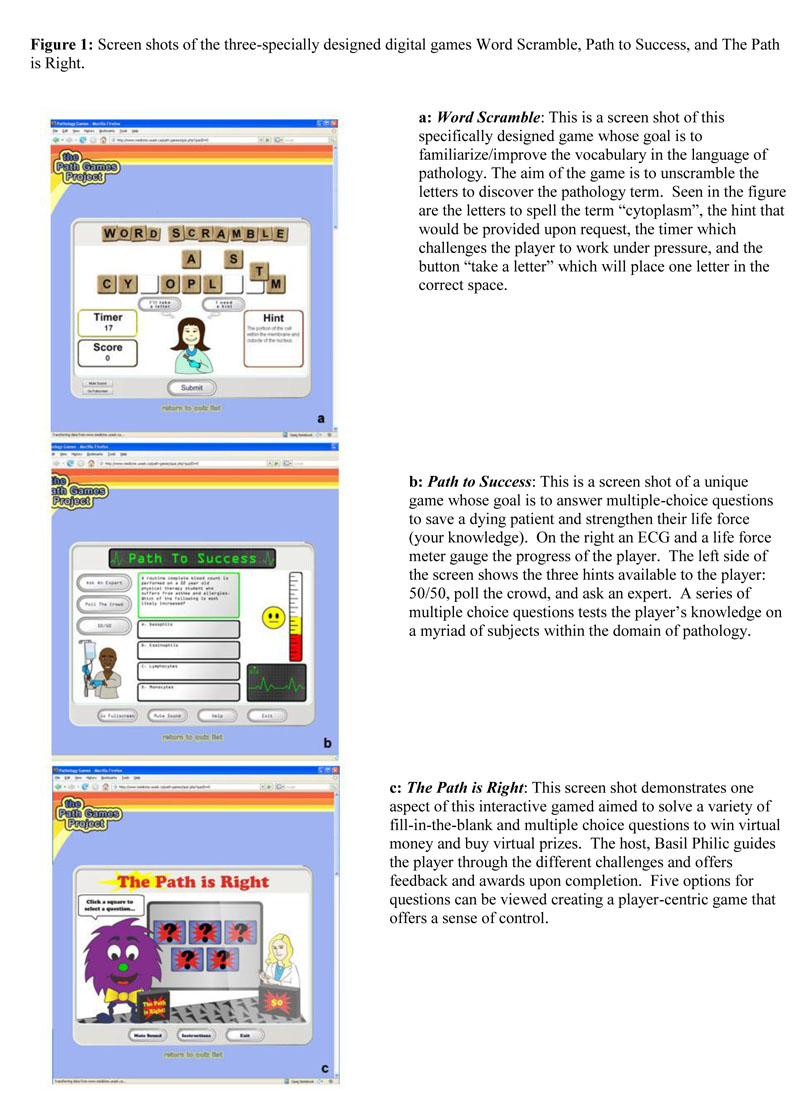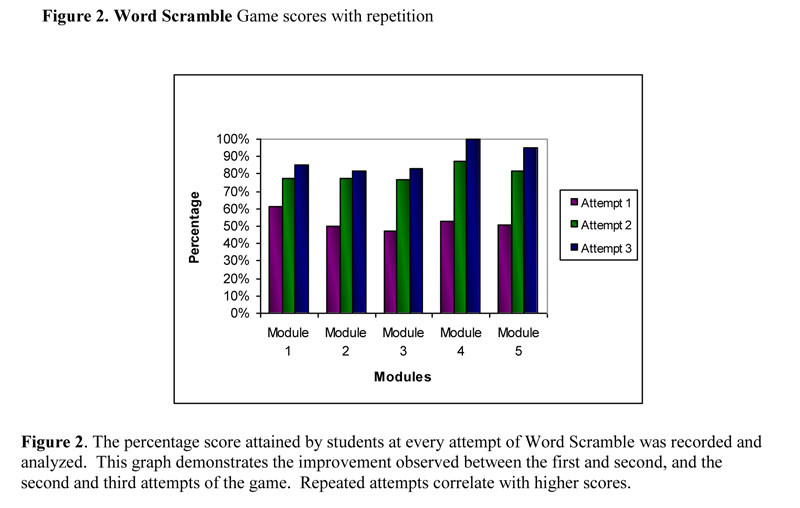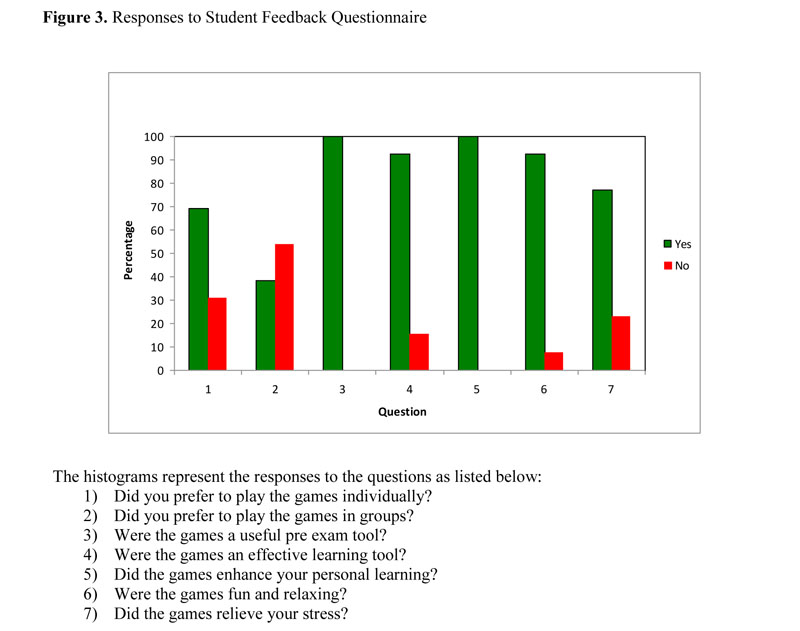ABSTRACT
Computer-savvy net-generation students think and learn in different ways. Three educational games of varied complexity were designed for medical, dental and physical therapy students. Student feedback and examination performance outcomes were positive. Specially-constructed digital games offer an enhanced, effective, non-threatening, fun, educational learning environment, with increased student engagement and satisfaction.
Since the 1960s, digital gaming has increased in popularity, creating a generation of “homo-zappiens” who think and learn differently. The electronic world has equipped students with a desire for a) instantaneous gratification b) stimulating visuals c) prizes for achievements, and d) continual accessibility. Due to changing expectations, conventional education does not effectively stimulate students. The merging of digital gaming and education, “edutainment”, combines the enticement of gaming with the importance of learning. E-learning strategies offer students a holistic education to mirror their capacity of elastic-learning.
In response to these changes, a collaborative project to create specially-designed digital games as a teaching/learning tool was undertaken by the College Of Medicine at the University Of Saskatchewan with members of a developmental team from Educational Media Access and Production (EMAP), facilitated by a technology-enhanced-learning (TEL) grant from the provincial government. Game design principles included strategic-thinking and problem-solving thereby contextually bridging the gap between the theory and application in a fun, game-like atmosphere. User-friendly games were focused on time-on-task activities with motivation and goal-orientation through rewards, clues, and partial-solutions to maintain progression and self-direction of individual learning.
Game One: Word Scramble reviews the new content-specific medical vocabulary, terminology, and factual knowledge utilized in the pathology courses (Figure 1a). In one minute students must descramble the letters to unravel a pathological term, gaining points for correct letter placement, emphasizing the value of accurate spelling. Help features of a hint option provides a brief definition of the term, enforcing word meanings, and a “take a letter” option places one letter in the correct spot. Each game is composed of ten words. First-time scores ranged from 47.75-62.4%, (overall average 51.64%), increasing to 78.07% (76.14%-82.06%) on students’ second attempt and continued to escalate. An overall percentage improvement of 26.43% (13.52-34.31%) was observed (Figure 2). The game Word Scramble proved to be an effective learning tool for students who attempted the activity multiple times. Qualitative data indicates students found this game to be useful in building/improving their vocabulary.
Game Two: Path to Success challenges the player to correctly answer multiple choice questions in order to save a patient (Figure1b). The patient’s life force and ECG reading reflects the player’s score. Three forms of help are available to the players: ask an expert, poll the crowd, and 50/50. Each form of help may be used once with no added penalty. Upon completion of the game a feedback page appears, informing the player of their success rate.
Game Three: The Path is Right introduces a new host, Basil Philic, who guides the player through the game (Figure1c). Players place wagers on each question, then answer the multiple choice, fill-in-the-blank, and extended-matching questions to win or lose this amount. Upon completion of one of the three sections of the game, players may use their winnings to purchase virtual prizes.
Path to Success and The Path is Right were received with overwhelmingly positive student feedback (Figure 3). In their comments, students noted that the digital games provided a “relaxing, fun way to reinforce concepts/terminology”. 100% of the students found both these games to be a useful pre-exam review tool and an enhancer of personal learning. It was noted that the games “tested [their] knowledge base and detected areas of weakness”, encouraging student-centric learning. The majority (92%) of students found The Path is Right and Path to Success to be effective learning tools that reinforced concepts and terminology in pathology. Playing these games allowed students to “feel more confident in [their] knowledge”; while feeling “relaxed” (77%) (Figure 3).
Game data for analysis are available to faculty upon the student’ completion of the game. Results can be sorted by gender, score, date completed, area of study, and the questions answered. Besides providing routine demographic data points, this also highlights trends in areas of inadequate student knowledge that can be addressed.
Since their popularization in the 1960s, computers have become integral members of the learning environment1. Of the modern world, Prensky states “the human mind and imagination are not sufficient enough to imagine what is happening”2, a declaration reflected in the development and diversification of areas of studies that require an increase in information to be fit into curriculums already under a strict, inflexible timeframe3. The use of ‘after-hours’ gaming extends the learning environment outside of the classroom, opening up valuable contact time for the prescribed new content, thus, alleviating professor and student stress.
Our specially-designed digital games intricately balance educating, computing, and learning in an effort to create an appealing, imaginative, and creative game-design3,4. Educational and cognitive psychologists agree that individualized instruction taught by subject-matter experts is the best-practice educational model, a type of instruction only made possible virtually. Game ‘extras’, such as clues, hints, timers, and levels of difficulty personalize learning5. Game features such as ‘virtual’ prizes provide immediate feedback with instant gratification, facilitating information processing and true learning6.
“Some forms of learning are fast-paced, immensely compelling and rewarding whereas by comparison school strikes many…as slow and boring”7 writes Vivou et al, emphasizing the importance of student engagement in education. These thoughts are echoed by many education researchers who believe that people are happiest when they are completely absorbed in their activities8. As stated by Perensky “the key…is not curriculum, certification, or testing, but rather engagement”2. Digital games are an alternative educational tool for the current generation of students who demand challenges, instant gratification, immediate feedback, rewards, and accessibility as tools of engagement.
The educational design of all three of our digital games was based on the underlying principles of Bloom’s taxonomy of learning9; the first level is knowledge: the ability to remember, memorize, and recognize facts, evaluated through rote-memory questions. Short-term and long-term memory is enhanced through digital gaming as students are forced to quickly recollect information as demonstrated in Word Scramble. It is essential that these skills are honed and perfected before a higher level is attempted. Gaming allows for lessons that can be practiced repeatedly until mastered as computers [virtual instructor] have “infinite patience”. Comprehension of what has been learned is the second level, challenging students to interpret, discuss, and predict. Digital gaming can teach higher order thinking skills such as strategic thinking, interpretative analysis, problem solving, plan formulation and execution, and adaptation to rapid change. The third level is the application level: problem-solving, constructing, and illustrating information. Simulation games such as Immune Attack10 enhance this level, and are currently being used in defense, architecture, city planning, government companies, education and medicine. The importance of information application through digital games drives home the concepts in real time. Application of facts to a life-like scenario bridges the gap between education and practice further emphasizing the relevance and importance of the information taught.
Traditional education has focused on the “three Rs” of learning (reading, writing and arithmetic). Currently, students yearn for ‘three Es’: Education, Engagement, and an Extended learning environment. Specially-constructed digital games offer an enhanced, effective, non-threatening, fun, educational learning environment, with increased student engagement and satisfaction. Digital games as educational tools provide dual opportunities by enhancing traditional and contemporary student-learner experiences. Future plans include using digital games for nursing and pharmacy students. Ongoing research is also proposed in the design/construction of higher level thinking games.



CONFLICT OF INTEREST
Authors have no conflict of interest to declare.
ACKNOWLEDGEMENT
This work was supported in part by Saskatchewan Technology Enhanced Learning project grant
REFERENCES
- Rosser, J., Lynch, P., Cuddihy, L., Gentile, D.A., Klonsky, J., Merrell, R. The impact of video games on training surgeons in the 21st century. Archives of Surgery. 2007;142:181-186.
- Prensky, M. Speaking topics for education, corporate, and general audiences. [Accessed on April 28, 2009.].
- Reuiz, J., Mintzer, M., and Leipzig,R. The impact of e-learning in medical education. Academic Medicine 2006; 81: 207-212.
- Howarth-Hockey, G., and Stride, P. Can medical education be fun as well as educational? British Medical Journal. 2002; 325: 1453-1454.
- Gentile, D., Gentile, J. Violent video games as exemplary teachers: A conceptual analysis. Journal of Youth and Adolescence 2008; 37: 127–141.
- Ogershok, P., Cottrell, S. The pediatric board game. Medical Teacher 2004;26: 514-517.
- Vivou, M., Katsionis, G., Manos, K. Combining software games with education : evaluation of its education effectiveness. Educational Technology and Society 2005; 8: 54-65.
- Beylefeld, A., Struwig, M. A gaming approach to learning medical microbiology: students’ experiences of flow. Medical Teacher 2007;29: 933-940.
- Seddon, G.M. The properties of Bloom’s taxonomy of educational objectives for the cognitive domain. Review of Educational Research 1978;48(2):303-23.
- Kelly, H., Howell, K., Glinert, E., Holding, L., Swain, C., Burrowbridge, A., Roper, M. How to build serious games. Communications of the Association for Computing Machinery 2007; 50 (7): 45-49.